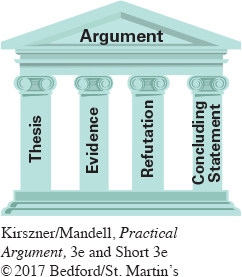Wiehe, Nothing Pretty in Child Pageants
EXERCISE 14.5
The following commentary, “Nothing Pretty in Child Pageants,” includes the basic elements of an evaluation argument. Read the essay, and then answer the questions that follow it, consulting the outline in “Structuring an Evaluation Argument” if necessary.
This article was published in the Lexington Herald-
NOTHING PRETTY IN CHILD PAGEANTS
VERNON R. WIEHE
1
Toddlers and Tiaras is a televised beauty pageant for very young children which appears weekly ironically on The Learning Channel. The Web site for the show describes it this way: “On any given weekend, on stages across the country, little girls and boys parade around wearing makeup, false eyelashes, spray tans, and fake hair to be judged on their beauty, personality, and costumes. Toddlers and Tiaras follows families on their quest for sparkly crowns, big titles, and lots of cash.”
2
A TV viewer will see the program’s feeble attempts at Las Vegas–
3
The viewer will also be taken behind the scenes to witness temper tantrums from children resisting the role into which they are being put. On a recent show, a 2-
4
It raises questions for the viewer: Whose idea is this—
5
The potential impact of child beauty pageants may be viewed in terms of the fallacious arguments most frequently cited in support of this activity:
All Little Girls Like to Play Dress-
6
Dress-
Page 528
7
First, dress-
8
Second, competition, an important element in child beauty pageants, ranks contestants, with one child becoming a winner and the others losers.
9
Third, dress-
10
Parents certainly have a right to spend their money on children as they wish, but if this expenditure of money and effort is for the ultimate goal of the child winning the contest and the child fails to do so, what is the emotional cost to the child? What happens to the child’s self-
Children’s Beauty Pageants Teach Poise and Self-
11
Even if the pageants do foster the development of these attributes, the question must be raised whether poise and self-
12
Sexualization occurs through little girls wearing adult women’s clothing in diminutive sizes, the use of makeup which often is applied by makeup consultants, spray tanning the body, the dying of hair and the use of hair extensions, and assuming provocative postures more appropriate for adult models.
13
The sexualization of young children sends a conflicting message to the child and a dangerous message to adults. To the child, a message is given that sexuality—
Children Enjoy Participating in Beauty Pageants
14
While young children may express enjoyment in participating in pageants, children are eager to please adults. Sleeping with their hair in curlers, having to sit quietly while their hair is being tinted or rolled, fake nails being applied, or their body being spray tanned hardly seems like activities very young girls would choose over having fun with friends in age-
Participation in Beauty Pageants Is No Different from Participating in Athletic or Suzuki Music Education Programs
15
Children’s athletic programs and music education programs teach skills appropriate to the developmental stage of the child upon which the child can build later in life rather than emphasizing the beauty of the human body that can change significantly with time. In Suzuki recitals, for example, the unique contribution of each child is recognized and no child loses.
Page 529
16
“Do child beauty pageants constitute child abuse?”
Do child beauty pageants constitute child abuse?
17
This question must be answered on an individual basis. Parents who force their children to participate in pageants, as well as in athletic and music education programs, can be emotionally and even physically abusive, if participation is meeting parental needs rather than the needs of the child.
18
The risk for such abuse to occur is perhaps greatest when children are not recognized for what they are—
19
Play is an important factor in children’s early development because, through play, they learn skills for adulthood.
20
After all, what is the rush to become an adult?

Identifying the Elements of an Evaluation Argument
Wiehe does not state his thesis directly. Write a thesis statement for this essay by filling in the template below. (Hint: Try answering the questions Wiehe asks in paragraph 4.)
Because ____________________________, beauty pageants are bad for children.
What criteria does Wiehe use to evaluate child beauty pageants? If he wanted to make the opposite case, what criteria might he use instead?
In his essay’s boldface headings, Wiehe identifies four opposing arguments. Which of these opposing arguments do you think presents the strongest challenge to Wiehe’s position? Why?
Do you think Wiehe expects his readers to have seen the program Toddlers and Tiaras? Does he expect them to have strong feelings about child beauty pageants? How can you tell?
After he has refuted arguments against his position, Wiehe (a professor emeritus of social work) begins a discussion of whether “child beauty pageants constitute child abuse” (para. 16). Should he have done more to prepare readers for this discussion? Explain.
Do you think Wiehe’s concluding statement would have a greater impact if it were in the form of a statement rather than a question? Write a new sentence that could serve as a strong concluding statement for this essay.